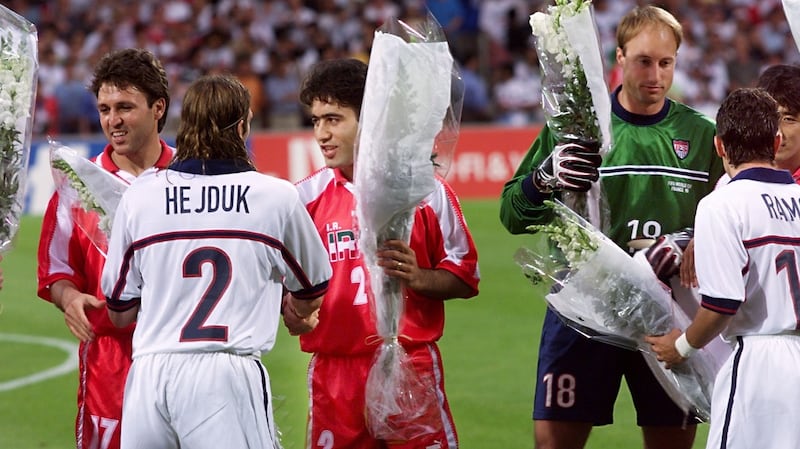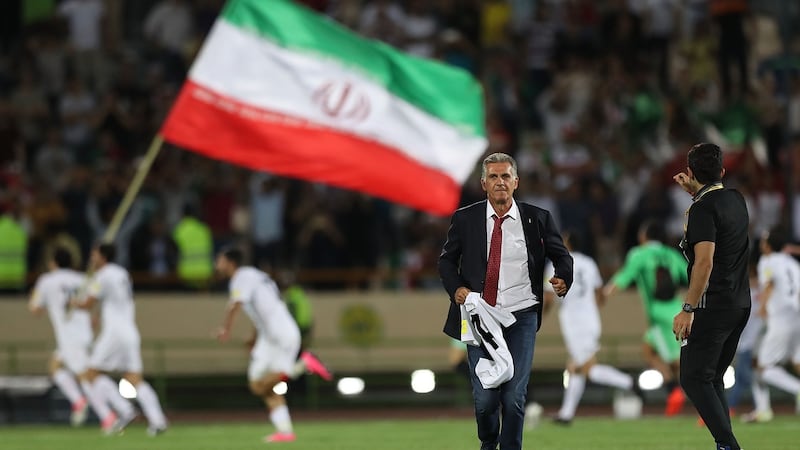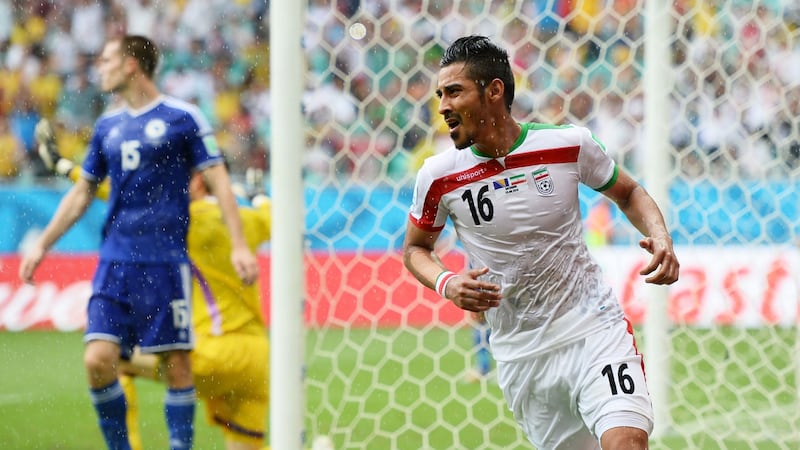When Iran were drawn in the same group as the US at France ’98, the organisers immediately began preparing for an encounter that would be political pageant as much as football match.
It coincided with a period of political re-engagement between the Clinton administration in Washington and Mohammad Khatami, Iran’s leader, who, in January of that year, had encouraged further communications between the countries in a CNN interview.
By the summer, the Group F match was framed as a symbolic meeting between the countries, placing the footballers in a strange position.
“If we establish good relations with another country, fine: just give us the three points,” said Alexis Lalas, the flame-haired striker who was the face of US soccer in the mid-90s. Bill Clinton used the match to deliver a folksy riff on fatherhood (it was Father’s Day in the States) which intensified the spotlight on the occasion.
It was a nervous moment for the hosts, who had already caused deep indignation in the Iranian camp when a French television channel broadcast Not Without My Daughter, a Sally Field film about an American woman who flees her abusive Iranian husband.
The Iranians were incensed by the depiction of the homeland and lodged a protest with Fifa, claiming the film was an outrage against their country – and possibly against cinema itself. The occasion itself was also delicate. The first problem was that Iran, Team B, were supposed to walk towards Team A – the Americans – under protocol.

Scouring the Fifa handbook, supreme leader Khamenei took a dim view of this scenario and issued express word that there would be no walk. It emerged that some 7,000 match tickets for Lyon had been acquired by Mujahedin-e Khalq, an Iraq-based protest group funded by the Hussein regime with the goal of destabilising Iran. They turned up in Lyon with the genuine fans and smuggled banners and placards into the arena with plans to stage a pitch invasion if necessary.
As it happened, the match became one of the inadvertent triumphs of the tournament. The American team readily agreed to walk over to the Iranians, who carried white flowers to present to their adversaries: both teams mingled for the pre-match photograph that was part historic photo-op, part horticultural extravaganza.
Television cameramen kept their lens away from the section of the stadium where Khalq members stood and off-camera police formed a cordon to ensure there would be no invasion. Iran played out of their skins and won 2-1, provoking the most liberal outpouring of joy in Tehran since the Islamic revolution of 1979 – people danced and drank alcohol on the streets. Women removed their head scarves.
The regime at once marvelled at the national pride invoked by football and feared the state of collective bliss that swept through the people, undermining the doctrine.
Those 90 minutes against the US captured Iran’s conflicted emotions about the beautiful game. The country’s national love affair with football was one of the few characteristics that remained unchanged after the Pahlavi royal dynasty was overthrown in the 1979 revolution.

Although the Islamic reforms were instant and sweeping, the regime understood that trying to oppress football, along with other expressions of western-influenced culture, would simply be too difficult.
Since 1925, when Reza Shah Pahlavi saw in football the ideal way to inculcate western values in the country, the game had taken off. Mosques were razed to provide more pitches in those early years; players became national icons and prior to the 1979 revolution, Iran produced exceptional football teams, winning the Asian cups of 1968, 1972 and 1976.
The 1968 win over Israel had been toxic and dramatic, with the dashing Parviz Ghelichkhani scoring the crucial 86th-minute goal in a 2-1 win in front of 30,000 ecstatic supporters in the Amjadeih stadium in Tehran. Ghelichkhani was a football idol with strong political views; he objected to both the crumbling Pahlavi dynasty and to the doctrines of the Islamic revolution and ended up among the exiles, moving to France where he has lived since.
But while footballers were lost to the upheaval, the game itself was not. Instead, the regime tried to control its emotional pull on Iranians. It was made a male-only preserve, with Iranian women banned from watching or attending games. Club games were subject to delayed broadcasts and, until the summer of 1998, celebrations were muted.
The striking thing about the state of Iran football team 20 later is its absolute consistency. The exploits of the 1998 team were so unexpected that they became dream-like: they were last-placed qualifiers after an absorbing play-off against Australia and then they beat the US – it was the stuff of folklore. The 2018 version is different.
Carlos Queiroz’s side have been dauntingly reliable; the highest ranked Asian team over the past four years, no defeats in their 16-game qualifying run which included 34 goals scored and just three conceded. When they officially qualified with a 2-0 win over Uzbekistan in July 2017, only 60,000 fans were in the Azadi stadium because of an attack on parliament by Islamic State earlier that week. But over 100,000 had been there to cheer them on against China – would that the FAI have such ticketing problems.
Iran are in a horrible group along with Spain, Portugal and Morocco but none of those three will relish playing them. Querioz has developed one of the most interesting CVs in elite football, spending six seasons listening to Alex Ferguson’s Govan Esperanto as his right-hand man at Old Trafford, as well as taking the hot seat at Real Madrid for a lone season.

But he has specialised in bringing football nations to the World Cup: he guided South Africa to the 2002 tournament (but departed before a ball was kicked after a row with his employers); qualified his native Portugal in 2010; and this will be his second appearance with Iran.
Querioz himself has been the most turbulent element of the national team, vociferous in demanding better financing of his team, drawing on Iran’s expatriate community in “foreign” players like Reza Ghoochannejhad, the 23-year-old striker born in Mashhad who moved to the Netherlands aged four, and, more controversially, American-born Steve Beitashour, who made the preliminary squad for Russia but not the last 23. Querioz has already declared that the tournament will end his involvement with Iran.
“It’s almost one year since we qualified for the World Cup and it’s true that they gave me an offer to go for six months to the Asian Cup in the Emirates but it didn’t meet my expectations,” he said in May. “The more I started to think about that unique historical opportunity, to be the only coach in football history to have five World Cup qualifications under my belt, my anger and desire started to grow and this is now my main goal and expectation.”
But Querioz has threatened – and executed – his resignation before. Whether this latest outburst is just a preamble to secure better terms might well depend on how Iran performs.
The tournament will hold its citizens – of both sexes – spellbound. A 2005 reform to allow Iranian women to attend games was overturned, prompting the recent phenomenon of Iranian women disguising their gender with male beards and wigs so they can follow their club teams. Twenty years on, the brief reconciliation achieved by the football teams of Iran and US – “we furthered relations by about 10 years in 90 minutes,” said the American defender Jeff Agoos – has been forgotten and diplomatic relations between the countries are ice cold and hostile.
What is remembered, in Iran at least, is the scoreline and that intoxicating feeling of winning big at football. They are hoping for another taste of that in Russia this summer.











